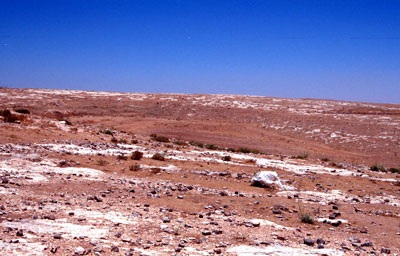Current Issues in Land Resources of the Karak Plateau
A major land resource issue is the amount of erosion occurring on landscapes in the region. Erosion is not a new problem in the region, as many landscapes show the impact of centuries of agricultural tillage and removal of the natural vegetation, whether forest or grasslands. Erosion is a major problem because of the many steep slopes and also the loess is highly erodible. Although wind erosion is more noticeable, water erosion is probably of equal or greater importance. Wind erosion is not as serious on silty soil because of the high threshold wind velocity needed to initiate erosion, as contrasted to sandy soils.
Fajj al-Usaykir
The region south of al-Karak (Unit 7), for example, shows many eroded areas where bedrock outcrops may occur on 40% of the landscapes. Once the loess is removed, the soil formed on the limestone is usually very shallow and thus agriculture is no longer viable. Another major area of eroded landscapes is northeast of al-Karak near the city of Adir. This region has a shallow loess cap over calcrete or petrocalcic horizon. The calcrete horizon is cemented by calcium carbonate (lime) and is similar in hardness to bedrock and will not support plants. Calcrete horizons occur in other areas of the plateau; where the loess soil overlying this horizon is removed by erosion, agriculture is not feasible.
General topography of the Fajj al-Usaykir
As irrigation becomes more abundant on the Karak Plateau as a result of two large dams being built in Wadi al-Mujib and Wadi al-Hasa, decisions on potential areas to irrigate must be made. A major consideration of where to irrigate must include the soil resource, both from the standpoint of potential yields and the environmental impact of irrigation on the soils and landscapes. Soils on Fajj al-Usaykir (Unit 9), for example, would provide a large area of gently sloping landscapes with a high potential for agricultural production; additional studies would need to be made for soil protection from erosion and excess salts that may be liberated by the irrigation water.
As with many other areas undergoing development, especially expansion of urban areas, regions of the best agricultural soils are some of the first areas to be transformed from agriculture to urban. The location of some of the major towns on the Karak Plateau occurs in many of the best agricultural regions. For example, units 2, 3, and 4 are some of the best agricultural areas with adequate soils and the best precipitation values on the plateau, but these areas also have some of the most rapid growing urban areas. Land planning for development of both agriculture and urban regions is needed.
Sheep and goats grazing
Overgrazing is a major problem in many parts of the world, especially in areas of limited rainfall and fragile soils. The eastern portion of the Karak Plateau, where rainfall is <100 mm and soils are shallow, is especially an environmentally sensitive area. Because of overgrazing, the vegetation has probably changed drastically in the past several centuries. The pressure for grazing lands during drought periods has been especially hard on the vegetation resource. Similar situations have occurred in the western regions of the U.S. under heavy grazing where dry conditions and shallow soils have resulted in lands that presently have minimal value for grazing.


